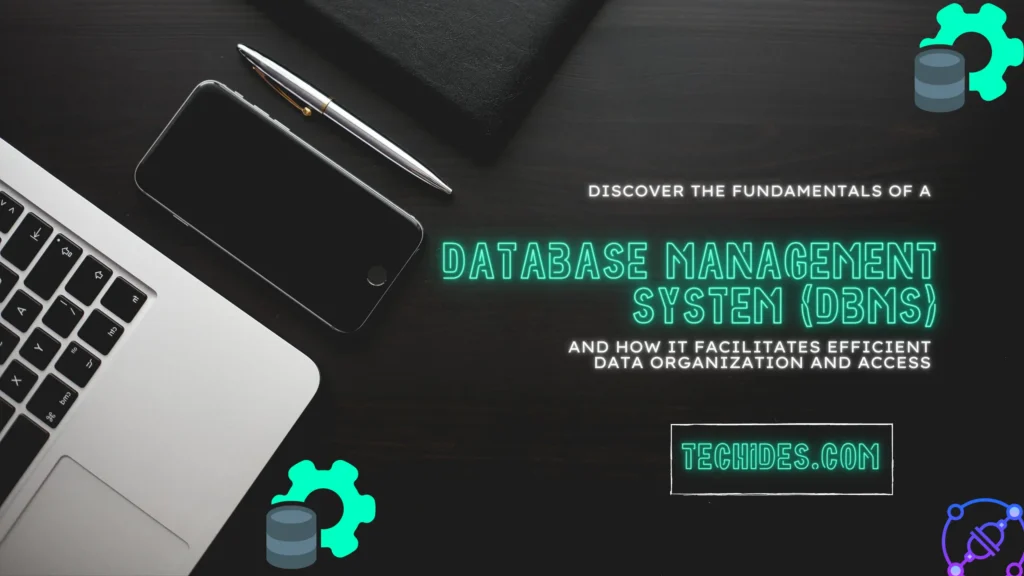Introduction
Businesses and organizations rely heavily on data to make informed decisions and gain a competitive edge in the digital age. Managing this vast amount of data efficiently and securely is crucial. This is where Database Management Systems (DBMS) play a vital role. In this article, we will explore the concept of DBMS, its importance, different types, advantages, disadvantages, architecture, popular tools, and future trends.
What is DBMS?
Definition of DBMS
DBMS is a software system that facilitates the creation, organization, retrieval, and manipulation of data in a database. It provides an interface between users and the database, allowing efficient management of data and ensuring data integrity.
Components of DBMS
DBMS consists of three main components:
- Data Definition Language (DDL) defines the database structure and schema.
- Data Manipulation Language (DML) allows users to manipulate data, perform queries, and modify the database.
- Data Control Language (DCL) controls user access and permissions to ensure data security.
Importance of DBMS
DBMS offers several benefits that contribute to the efficient management of data:
Data Organization
DBMS provides a structured approach to storing and organizing data. It ensures that data is logically arranged, making it easier to retrieve and analyze. This organized data structure improves overall system performance.
Data Security
Data security is a top priority for businesses. DBMS offers robust security mechanisms to protect sensitive information from unauthorized access, ensuring data confidentiality, integrity, and availability. It implements user authentication, access control, and encryption techniques.
Data Integration
DBMS enables data integration by allowing multiple applications to access the same database concurrently. This integration eliminates data redundancy and inconsistency, providing users with a unified view of the data across different departments.
Types of DBMS
There are various types of DBMS, each suited for specific requirements:
Relational DBMS
Relational DBMS (RDBMS) is based on the relational model, which organizes data into tables with rows and columns. It establishes relationships between tables through keys, enabling efficient data retrieval using SQL queries. Examples include MySQL, PostgreSQL, and Microsoft SQL Server.
Object-Oriented DBMS
Object-Oriented DBMS (OODBMS) stores data as objects, which can encapsulate data and behaviour. It allows complex data modelling, inheritance, and polymorphism, making it suitable for applications with complex data structures. Examples include MongoDB and Apache Cassandra.
Hierarchical DBMS
Hierarchical DBMS organizes data in a tree-like structure with parent-child relationships. It is efficient for one-to-many relationships but can become complex for many-to-many relationships. IBM’s Information Management System (IMS) is a popular hierarchical DBMS.
Network DBMS
Network DBMS uses a graph-like model to allow a more flexible relationship structure between entities. It can handle complex data relationships but can be challenging to manage. Integrated Data Store (IDS) and Integrated Data Store 2 (IDS2) are examples of network DBMS.
Advantages and Disadvantages
Advantages of DBMS
- Improved data sharing and data integration across applications.
- Data consistency and integrity are maintained through built-in constraints.
- Data security mechanisms ensure protection against unauthorized access.
- Efficient data retrieval using structured query languages.
- Scalability and flexibility to accommodate growing data volumes and changing requirements.
Disadvantages of DBMS
- High initial setup and maintenance costs.
- Requires skilled professionals to design, implement, and manage the database system.
- Complex backup and recovery procedures in case of system failures.
- Performance overhead due to the additional layer of abstraction.
- The potential risk of data loss or corruption if not managed properly.
DBMS Architecture
Three-Schema Architecture
DBMS follows a three-schema architecture:
- External Schema: It defines how each user or application views the database.
- Conceptual Schema: It represents the overall logical view of the entire database.
- Internal Schema describes how data is physically stored in the database system.
Database System Catalog
DBMS maintains a database system catalogue that stores metadata about the database. It includes information about tables, views, indexes, users, and their privileges. The catalogue is essential for efficiently operating and managing the database system.
Common DBMS Tools
Several popular DBMS tools are widely used in the industry:
MySQL
MySQL is an open-source RDBMS known for its scalability, reliability, and ease of use. Web applications and power numerous websites worldwide widely adopt it.
Oracle
Oracle Database is a robust and feature-rich RDBMS trusted by enterprises for large-scale data management. It offers advanced security, high availability, and extensive analytical capabilities.
Microsoft SQL Server
Microsoft SQL Server is a comprehensive RDBMS that integrates well with other Microsoft products. It provides excellent scalability, security features, and business intelligence capabilities.
Future Trends in DBMS
DBMS is an evolving field, and several trends are shaping its future:
- Cloud-based DBMS: Increasing adoption of cloud computing and the need for scalability and flexibility drive the shift toward cloud-based DBMS.
- NoSQL databases: Non-relational databases, such as document-oriented and graph databases, are gaining popularity for handling unstructured and complex data.
- Big Data Analytics: DBMS is evolving to handle massive volumes of data generated by IoT devices, social media, and other sources. Big Data analytics capabilities are becoming essential for businesses.
Conclusion
DBMS plays a critical role in managing data efficiently and securely. It offers numerous advantages, including improved data organization, enhanced security, and seamless integration. With various types of DBMS available, businesses can choose the one that best suits their requirements. DBMS continues to evolve as technology advances, embracing trends like cloud computing, NoSQL databases, and Big Data analytics.
FAQs
What is the difference between DBMS and RDBMS?
DBMS is a broader term encompassing various database management systems, including RDBMS. RDBMS follows the relational model and stores data in tables with predefined relationships.
Is DBMS only used for large-scale businesses?
No, DBMS is used by businesses of all sizes. Even small-scale businesses can benefit from efficient data management and security offered by DBMS.
Can I switch from one DBMS to another?
It is possible to switch from one DBMS to another, but it requires areful planning, data migration, and application compatibility testing.
Are there any free DBMS options available?
Yes, several open-source DBMS options, such as MySQL and PostgreSQL, are available for free. They offer robust features and community support.
How does DBMS ensure data integrity?
DBMS enforces integrity constraints, such as unique keys and referential integrity, to ensure data accuracy and consistency. It prevents data duplication and maintains data relationships.



